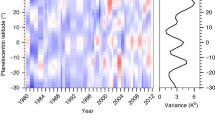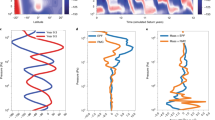Abstract
The zonal jets on the giant planets have been thought to be stable in time1,2,3. A decline in the velocity of Saturn’s equatorial jet has been identified, on the basis of a comparison of cloud-tracking data across two decades4, but the differences in cloud speeds have since been suggested to stem from changes in cloud altitude in combination with vertical wind shear, rather than from temporal changes in wind strength at a given height5. Here, we combine observations of cloud tracks and of atmospheric temperatures taken by two instruments on the Cassini spacecraft to reveal a significant temporal variation in the strength of the high-altitude equatorial jet on Saturn. Specifically, we find that wind speeds at atmospheric pressure levels of 60 mbar, corresponding to Saturn’s tropopause, increased by about 20 m s−1 between 2004 and 2008, whereas the wind speed has been essentially constant over time in the southern equatorial troposphere. The observations further reveal that the equatorial jet intensified by about 60 m s−1 between 2005 and 2008 in the stratosphere, that is, at pressure levels of 1–5 mbar. Because the wind acceleration is weaker near the tropopause than higher up, in the stratosphere, we conclude that the semi-annual equatorial oscillation of Saturn’s middle atmosphere6,7 is also damped as it propagates downwards.
This is a preview of subscription content, access via your institution
Access options
Subscribe to this journal
Receive 12 print issues and online access
$259.00 per year
only $21.58 per issue
Buy this article
- Purchase on Springer Link
- Instant access to full article PDF
Prices may be subject to local taxes which are calculated during checkout


Similar content being viewed by others
References
Irwin, P. G. J. Giant Planets of Our Solar System 141–142 (Praxis Publishing, 2003).
Cho, J. Y. & Polvani, L. M. The morphogenesis of bands and zonal winds in the atmospheres on the giant outer planets. Science 19, 335–337 (1996).
Galperin, B., Sukoriansky, S. & Huang, H. Universal n−5 spectrum of zonal flows on giant planets. Phys. Fluids 13, 1545–1549 (2001).
Sanchez-Lavega, A., Perez-Hoyos, S., Rojas, J. F. & French, R. G. A strong decrease in Saturn’s equatorial jet at cloud level. Nature 423, 623–625 (2003).
Porco, C. C. et al. Cassini imaging science: Initial results on Saturn’s atmosphere. Science 307, 1243–1247 (2005).
Fouchet, T. et al. An equatorial oscillation in Saturn’s middle atmosphere. Nature 453, 200–202 (2008).
Orton, G. S. et al. Semi-annual oscillations in Saturn’s low-latitude stratospheric temperatures. Nature 453, 196–199 (2008).
Flasar, F. M. et al. Temperatures, winds, and composition in the Saturnian system. Science 307, 1247–1251 (2005).
Li, L. et al. Strong jet and a new thermal wave in Saturn’s equatorial stratosphere. Geophys. Res. Lett. 35, L23208 (2008).
Perez-Hoyos, S. & Sanchez-Lavega, A. On the vertical wind shear of Saturn’s equatorial jet at cloud level. Icarus 180, 161–175 (2006).
Sanchez-Lavega, A., Hueso, R. & Perez-Hoyos, S. The three-dimensional structure of Saturn’s equatorial jet at cloud level. Icarus 187, 510–519 (2007).
Leovy, C. B., Friedson, A. J. & Orton, G. S. The quasi-quadrennial oscillation of Jupiter’s equatorial atmosphere. Nature 354, 380–382 (1991).
Simon-Miller, A. A. & Gierasch, P. J. On the long-term variability of Jupiter’s winds and brightness as observed from Hubble. Icarus 210, 258–269 (2010).
Garcı´a-Melendo, E., Sánchez-Lavega, A., Rojas, J. F., Pérez-Hoyos, S. & Hueso, R. Vertical shears in Saturn’s eastward jets at cloud level. Icarus 201, 818–820 (2009).
Garcia-Melendo, E., Sanchez-Lavega, A., Legarreta, J., Perez-Hoyos, S. & Hueso, R. A strong high altitude narrow jet detected at Saturn’s equator. Geophys. Res. Lett. 37, L22204 (2010).
Limaye, S. S. Jupiter: New estimates of the mean zonal flow at the cloud level. Icarus 65, 335–352 (1986).
Fletcher, L. N. et al. Seasonal change on Saturn from Cassini/CIRS observations, 2004–2009. Icarus 208, 337–352 (2010).
Guerlet, S., Fouchet, T., Bezard, B., Flasar, F. M. & Simon-Miller, A. A. Evolution of the equatorial oscillation in Saturn’s atmosphere between 2005 and 2010 from Cassini/CIRS limb data analysis. Geophys. Res. Lett. 38, L09201 (2011).
Schinder, P. J. et al. Saturn’s equatorial oscillation: Evidence of descending thermal structure from Cassini radio occultations. Geophys. Res. Lett. 38, L08205 (2011).
Baines, K. H. et al. Polar lightning and decadal-scale cloud variability on Jupiter. Science 318, 226–229 (2007).
Li, L. et al. Emitted power of Jupiter. J. Geophys. Res. 115, E11002 (2010).
Baldwin, M. P. et al. The quasi-biennial oscillation. Rev. Geophys. 39, 179–229 (2001).
Acknowledgements
NASA Cassini Data Analysis Program funded this work. We acknowledge E. Garcia-Melendo, R. Hueso, A. Sanchez-Lavega, and S. Perez-Hoyos for providing comments and discussions. We are also grateful for comments and suggestions on this work from two anonymous reviewers.
Author information
Authors and Affiliations
Contributions
L.L. measured the ISS winds (correlated), computed the thermal winds and conceived the overall research. X.J. carried out the ISS wind measurements (cloud tracking). X.J., A.P.I., A.D.D.G., C.C.P., R.A.W., A.R.V., S.P.E., B.J.C., P.J.G., A.A.S-M., C.A.N., R.K.A., G.S.O., L.N.F. and K.H.B. provided assistance in interpreting the observational results.
Corresponding author
Ethics declarations
Competing interests
The authors declare no competing financial interests.
Supplementary information
Supplementary Information
Supplementary Information (PDF 954 kb)
Rights and permissions
About this article
Cite this article
Li, L., Jiang, X., Ingersoll, A. et al. Equatorial winds on Saturn and the stratospheric oscillation. Nature Geosci 4, 750–752 (2011). https://doi.org/10.1038/ngeo1292
Received:
Accepted:
Published:
Issue Date:
DOI: https://doi.org/10.1038/ngeo1292
This article is cited by
-
A pole-to-pole pressure–temperature map of Saturn’s thermosphere from Cassini Grand Finale data
Nature Astronomy (2020)
-
Cassini Exploration of the Planet Saturn: A Comprehensive Review
Space Science Reviews (2020)
-
How Well Do We Understand the Belt/Zone Circulation of Giant Planet Atmospheres?
Space Science Reviews (2020)
-
Disruption of Saturn’s quasi-periodic equatorial oscillation by the great northern storm
Nature Astronomy (2017)
-
An enduring rapidly moving storm as a guide to Saturn’s Equatorial jet’s complex structure
Nature Communications (2016)



